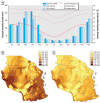Modeling the effects of weather and climate change on malaria transmission
- PMID: 20435552
- PMCID: PMC2866676
- DOI: 10.1289/ehp.0901256
Modeling the effects of weather and climate change on malaria transmission
Abstract
Background: In recent years, the impact of climate change on human health has attracted considerable attention; the effects on malaria have been of particular interest because of its disease burden and its transmission sensitivity to environmental conditions.
Objectives: We investigated and illustrated the role that dynamic process-based mathematical models can play in providing strategic insights into the effects of climate change on malaria transmission.
Methods: We evaluated a relatively simple model that permitted valuable and novel insights into the simultaneous effects of rainfall and temperature on mosquito population dynamics, malaria invasion, persistence and local seasonal extinction, and the impact of seasonality on transmission. We illustrated how large-scale climate simulations and infectious disease systems may be modeled and analyzed and how these methods may be applied to predicting changes in the basic reproduction number of malaria across Tanzania.
Results: We found extinction to be more strongly dependent on rainfall than on temperature and identified a temperature window of around 32-33 degrees C where endemic transmission and the rate of spread in disease-free regions is optimized. This window was the same for Plasmodium falciparum and P. vivax, but mosquito density played a stronger role in driving the rate of malaria spread than did the Plasmodium species. The results improved our understanding of how temperature shifts affect the global distribution of at-risk regions, as well as how rapidly malaria outbreaks take off within vulnerable populations.
Conclusions: Disease emergence, extinction, and transmission all depend strongly on climate. Mathematical models offer powerful tools for understanding geographic shifts in incidence as climate changes. Nonlinear dependences of transmission on climate necessitates consideration of both changing climate trends and variability across time scales of interest.
Figures



Similar articles
-
Modelling climate change and malaria transmission.Adv Exp Med Biol. 2010;673:184-99. doi: 10.1007/978-1-4419-6064-1_13. Adv Exp Med Biol. 2010. PMID: 20632538 Review.
-
Malaria resurgence risk in southern Europe: climate assessment in an historically endemic area of rice fields at the Mediterranean shore of Spain.Malar J. 2010 Jul 31;9:221. doi: 10.1186/1475-2875-9-221. Malar J. 2010. PMID: 20673367 Free PMC article.
-
Mathematical modeling of climate change and malaria transmission dynamics: a historical review.J Math Biol. 2018 Oct;77(4):857-933. doi: 10.1007/s00285-018-1229-7. Epub 2018 Apr 24. J Math Biol. 2018. PMID: 29691632 Review.
-
Intricacies of using temperature of different niches for assessing impact on malaria transmission.Indian J Med Res. 2016 Jul;144(1):67-75. doi: 10.4103/0971-5916.193285. Indian J Med Res. 2016. PMID: 27834328 Free PMC article.
-
Imported Plasmodium falciparum and locally transmitted Plasmodium vivax: cross-border malaria transmission scenario in northwestern Thailand.Malar J. 2017 Jun 21;16(1):258. doi: 10.1186/s12936-017-1900-2. Malar J. 2017. PMID: 28637467 Free PMC article.
Cited by
-
Temperature dependence of mosquitoes: Comparing mechanistic and machine learning approaches.PLoS Negl Trop Dis. 2024 Sep 16;18(9):e0012488. doi: 10.1371/journal.pntd.0012488. eCollection 2024 Sep. PLoS Negl Trop Dis. 2024. PMID: 39283940 Free PMC article.
-
Modeling the 2014-2015 Vesicular Stomatitis Outbreak in the United States Using an SEIR-SEI Approach.Viruses. 2024 Aug 18;16(8):1315. doi: 10.3390/v16081315. Viruses. 2024. PMID: 39205289 Free PMC article.
-
Disentangling the seasonality effects of malaria transmission in the Brazilian Amazon basin.R Soc Open Sci. 2024 Jul 3;11(7):231764. doi: 10.1098/rsos.231764. eCollection 2024 Jul. R Soc Open Sci. 2024. PMID: 39076372 Free PMC article.
-
Adapting to the shifting landscape: Implications of climate change for malaria control: A review.Medicine (Baltimore). 2024 Jul 19;103(29):e39010. doi: 10.1097/MD.0000000000039010. Medicine (Baltimore). 2024. PMID: 39029063 Free PMC article. Review.
-
Forest cover percentage drives the peak biting time of Nyssorhynchus darlingi (Diptera: Culicidae) in the Brazilian Amazon.Malar J. 2024 May 28;23(1):166. doi: 10.1186/s12936-024-04984-1. Malar J. 2024. PMID: 38807105 Free PMC article.
References
-
- Bacaër N. Approximation of the basic reproduction number R0 for vector-borne diseases with a periodic vector population. Bull Math Biol. 2007;69(3):1067–1091. - PubMed
-
- Bacaër N, Ouifki R. Growth rate and basic reproduction number for population models with a simple periodic factor. Math Biosci. 2007;210(2):647–658. - PubMed
-
- Bouma MJ, van der Kaay HJ. The El Nino Southern Oscillation and the historic malaria epidemics on the Indian subcontinent and Sri Lanka: an early warning system for future epidemics? Trop Med Int Health. 1996;1(1):86–96. - PubMed
-
- Craig MH, Snow RW, le Sueur D. A climate-based distribution model of malaria transmission in sub-Saharan Africa. Parasitol Today. 1999;15(3):105–111. - PubMed
Publication types
MeSH terms
Grants and funding
LinkOut - more resources
Full Text Sources
Medical

